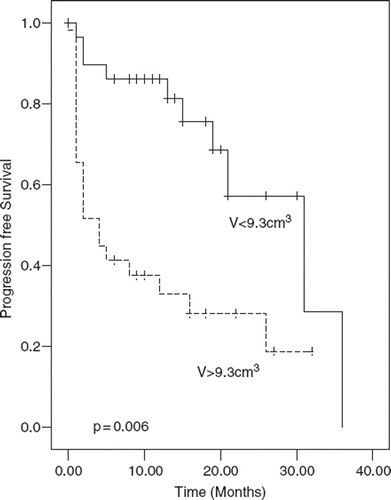Figures & data
Table I. Patient and disease characteristics at baseline.
Table II. Primary tumor and lymph node staging.
Figure 1. Head and neck tumor volume from an F-18 fluorodeoxyglucose-positron emission tomography (PET) study versus the maximal standardized uptake value (SUVmax) in the primary tumor (correlation coefficient [R2] =0.087). Y= 14.512+1.003*R2, R2=0.087.
![Figure 1. Head and neck tumor volume from an F-18 fluorodeoxyglucose-positron emission tomography (PET) study versus the maximal standardized uptake value (SUVmax) in the primary tumor (correlation coefficient [R2] =0.087). Y= 14.512+1.003*R2, R2=0.087.](/cms/asset/1008f0c4-edcb-4d41-935e-8fb818c3c18f/ionc_a_444388_f0001_b.gif)
Table III. Cox Proportional-hazards modeling parameters for progression free survival from head and neck cancer in all patients
Table IV. Cox proportional-hazards modeling parameters for survival from head and neck cancer in all patients
Figure 2. Progression free survival for two tumor volume subgroupings: tumor volume ≤ 9.3 cm3, tumor volume > 9.3 cm3, as labeled (p = 0.006).

Figure 3. Overall survival for two tumor volume subgroupings: tumor volume ≤ 9.3 cm3, tumor volume > 9.3 cm3, as labeled (p = 0.051).

![Figure 4. Progression free survival for two risk subgroupings: small volumes (≤ 9.3 cm3) and no lymph node involvement [Group I], larger volume and lymph node involvement [Group II], as labeled (p = 0.019).](/cms/asset/7def2d7d-6cd1-41cd-b117-8693665a5b15/ionc_a_444388_f0004_b.gif)
![Figure 5. Overall survival for two risk subgroupings: small volumes (≤ 9.3 cm3) and no lymph node involvement [Group I], larger volume and lymph node involvement [Group II], as labeled (p = 0.037).](/cms/asset/cbdcf9e4-d5a1-4713-ba53-3e7df86979a5/ionc_a_444388_f0005_b.gif)